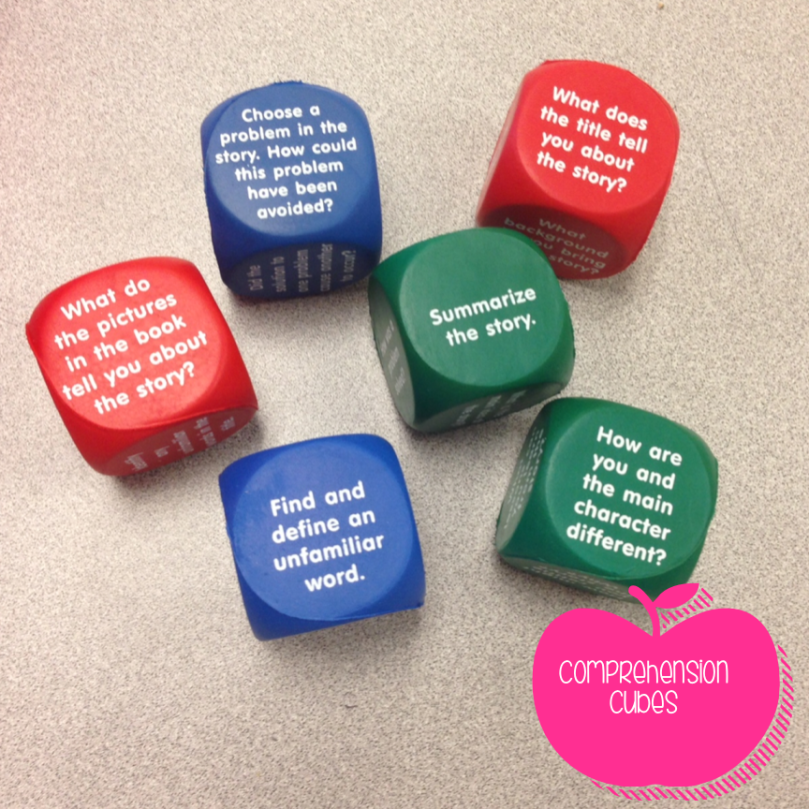Now that I do 99% of my teaching in small groups AND now that I got rid of my teacher desk, I found it even more crucial that I had an organized way to keep my guided reading tools within reach at all times.
It took some trial and error, but I have found that these tools in my Teacher Time/Guided Reading crate help me meet the needs of all my learners during their time with me. So what’s inside? Take a peak!
The best thing I did this summer was create the skills and strategies flip cards, as seen in my TPT store here. For real. Our learning goal this week and last has been to “Ask and answer questions about sequencing.” Our strategy has been to use our ability to sequence, to summarize the text. We referred to these flip cards as we read our weekly selection, as well as our leveled readers. That said, my goal was to get them simply used to seeing these guys around. We will begin to use them more in depth as I hand over the facilitation of our discussions to them.
Our phonics goal this week is learning how suffixes change the meaning of certain base words, so I kept those close at hand to whip out prior to reading, to review and get them ready to decode words.
The personal scale relates to what is expected of us in the county. I stapled these into the kids’ journals, and had them rate themselves by coloring in the box each day so far. Our goal is to get to a 3, though many are not satisfied until they can claim “4”. (I make this a huge deal, that certainly nobody can be a 4 on the first day or even second day, so they have a LOT to prove to me as we read together…evil.)
Back to the crate:
I found these cubes on Amazon for about $13. The kids LOVE these. The cubes are color coded, which this teacher just loves. The red cubes are for previewing the text, the blue is while you read, and the green is after reading. This makes it easy to guide your discussion with the kids, and they really feel like they are playing a game. So, it’s a win-win.
As you can see in the picture with my kids coloring in their scale, colorful writing utensils are necessary. Since I don’t have a desk, I keep my teacher pens in there. I use the markers when I need to make a quick anchor chart. It’s just another way to stay organized without my desk.
Put it all together, and life is easily prepared before the bell rings. I took a picture this morning of what my Teacher Time/Guided Reading table looked like before they walked in. I’ve done this each morning and found that it helps my brain stay organized during the usual controlled chaos of the morning, since we go straight from morning announcements into ELA. No time to waste.
So far, I cannot say enough about choosing to do most of my instruction in small groups. Staying organized helps me easily transition from one crew to another. While we use the same materials for the most part (such as the weekly text), the tools I use help me differentiate instruction based on their needs. I’ve noticed that my squirmy babies need to use the comprehension cubes to stay excited and focused, while my visual learners refer to the skills and strategies flip cards often for forming answers. Beyond that, all of the kids benefited from having the questions right in front of them, rather than projected on a screen as I did in all my years of whole group instruction. So yes, I feel strongly about small groups these days!
But that’s a post for another day!
Tell me what YOU do in small group instruction, like guided reading, and by the end of the week, I’ll be happy to pick someone to win a free Skills and Strategies Flip Cards set. 🙂








Looks so efficient! I do guided rewarding similarly where the students eventually lead the group. Those dice look awesome! Love the strategy cards too!
I love when it’s time to hand over the facilitation of discussions to the kids. We aren’t there yet, and won’t be for some time, but I do love my talks with them and listening to what they say to each other.
In small group we started genuine conversations with “piggy backing” and sharing new opinions. To help encourage all and provide security for those who need we use Skittles questions. The questions relate to the skill we are focusing on and increase in difficulty similar to Bloom’s. Each question has a color assigned to it. The students pick a skittle and they must share on that question. However, they are always welcome to piggy back or share a new opinion to other questions. This just ensures that everyone participates. We have used various colored candy to change things up.
I just created a small group bag at the end of last year, and I am always looking for new items to include in it…for math and reading. Open to ideas!
I love how you have them highlight the I can statements before guided reading. Where did you access these? I am definitely looking to start that routine!
Are you referring to the scale in their journals? If so, I typed those up to match our learning goal. So each box says the same thing for 1, 2, 3, and 4 through the week and they track their progress. 🙂 I can make those available after some editing!
Awesome!! Looking forward to adding this to my classroom!
Will you keep me posted when they become available please? 🙂 Thanks so much!!
Reblogged this on teachinginspo.